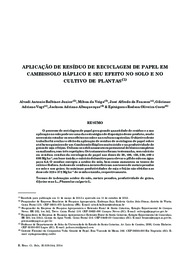Aplicação de resíduo de reciclagem de papel em Cambissolo Háplico e seu efeito no solo e no cultivo de plantas.
Aplicação de resíduo de reciclagem de papel em Cambissolo Háplico e seu efeito no solo e no cultivo de plantas.
Author(s): BALBINOT JUNIOR, A. A.; VEIGA, M. da; FONSECA, J. A. da; VOGT, G. A.; ALBUQUERQUE, J. A.; COSTA, E. R. O.
Summary: RESUMO: O processo de reciclagem de papel gera grande quantidade de resíduo e a sua aplicação no solo pode ser uma das estratégias de disposição desse produto, sendo necessário estudar os seus efeitos no solo e nas culturas agrícolas. O objetivo deste trabalho foi avaliar o efeito da aplicação de resíduo de reciclagem de papel sobre atributos químicos de um Cambissolo Háplico muito ácido e na produtividade de grãos de soja e feijão. Utilizou-se o delineamento experimental de blocos completos casualizados, com três repetições. Os tratamentos foram: testemunha, sem calcário ou resíduo; resíduo da reciclagem de papel nas doses de 50, 100, 150, 250, 400 e 600 Mg ha-1, em base úmida; e calcário dolomítico para elevar o pH do solo em água para 6,0. O resíduo corrigiu a acidez do solo, bem como aumentou os teores de cálcio e fósforo. As doses de resíduo não interferiram nos teores de metais pesados no solo e nos grãos. As máximas produtividades de soja e feijão são obtidas nas doses de 323 e 372 Mg ha-1 de resíduo úmido, respectivamente. ABSTRACT: The paper recycling process produces a large amount of waste and applying it on the soil may be one important strategy for use of this product. However, it is necessary to study the effects of application of this waste product on soil properties and crop performance. The aim of this study was to evaluate the effect of paper recycling waste on the chemical properties of an acidic Inceptisol and on the yield of soybean and common bean. A randomized complete block design was used, with three replications. The following treatments were evaluated: paper recycling waste at the rates of 50, 100, 150, 250, 400 and 600 Mg ha-1 of wet mass; dolomitic limestone to raise soil pH in water to 6.0; and a control, without waste or limestone application. The recycling waste increased soil pH and Ca and P levels. The application rates of recycling waste did not affect the levels of heavy metals in the soil and in the grains, even at the higher rates. The greatest yields of soybean and common bean were obtained at the rates of 323 and 372 Mg ha-1 of waste wet mass, respectively.
Publication year: 2014
Types of publication: Journal article
Unit: Embrapa Soybean
Keywords: Acid soils, Solo
Observation
Some of Embrapa's publications are published as ePub files. To read them, use or download one of the following free software options to your computer or mobile device. Android: Google Play Books; IOS: iBooks; Windows and Linux: Calibre.
Access other publications
Access the Agricultural Research Database (BDPA) to consult Embrapa's full library collection and records.
Visit Embrapa Bookstore to purchase books and other publications sold by Embrapa.

